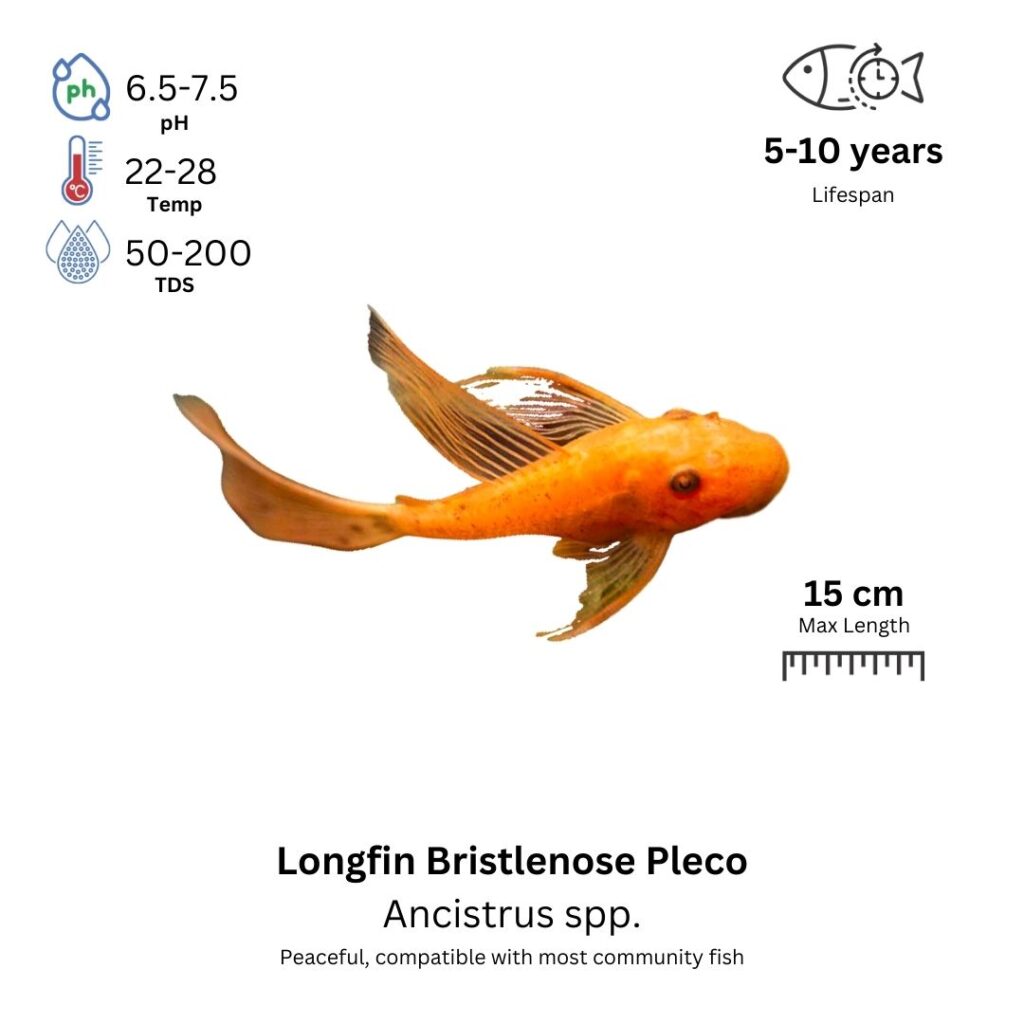Longfin Bristlenose Pleco
Ancistrus dolichopterus

Description
The Longfin Bristlenose Pleco is a fascinating and visually striking species of plecostomus, known for its long, flowing fins and characteristic bristles (appendages) that grow from the head, especially in males. The body of the Longfin Bristlenose is generally a brown to greyish color, often with lighter spots or patterns across the body. The long, delicate fins, which are where the “longfin” part of the name comes from, are often transparent with a frilly or feathered appearance. The bristles on the males’ snouts add to their unique appearance and are often a distinguishing feature used to differentiate males from females.
Habitat Origin
Native to the slow-moving rivers and streams of South America, particularly in countries like Brazil, Peru, and Ecuador, where they inhabit areas with soft, slightly acidic to neutral water. In the wild, they are often found in rocky, submerged areas with plenty of hiding spots, such as caves and crevices in the substrate. Their natural habitat provides plenty of surface area for them to graze on algae and biofilm.
Aquarium
Ideal Number in Aquarium: Best kept singly or in pairs. They can be kept with other peaceful species but should not be housed with aggressive or overly large fish.
Favorite Food

The Longfin Bristlenose Pleco is an omnivore, primarily feeding on algae, biofilm, and detritus. They will readily graze on algae, both in the tank and on decorations, rocks, and glass. In addition to algae, they should be offered a varied diet, including sinking pellets, wafers, and blanched vegetables such as zucchini, cucumber, and spinach. They may also enjoy occasional live or frozen foods like brine shrimp, bloodworms, or daphnia. A well-rounded diet is essential to keep them healthy and vibrant.
Behavior:
The Longfin Bristlenose Pleco is a peaceful, slow-moving fish that spends much of its time foraging for food on tank surfaces. As a nocturnal species, they are most active during the night, often hiding in caves, crevices, or behind plants during the day. They are very shy and should be provided with plenty of hiding spots to reduce stress. While they are peaceful, they can become territorial if kept with other plecos or bottom dwellers, especially if there isn’t enough space. Males, in particular, can be more territorial, especially during breeding periods.
Special Care:
Longfin Bristlenose Plecos are relatively easy to care for, but they do require stable water conditions. Regular water changes and good filtration are essential to maintain water quality, as they produce waste as part of their algae-eating behavior. They also benefit from having plenty of hiding spots in the aquarium, such as caves or driftwood, which replicate their natural habitat. A soft, fine substrate is ideal, as they often forage along the bottom for food.
Compatibility with Other Fish:
Yes, Longfin Bristlenose Plecos are compatible with many other peaceful species. They are best housed with other peaceful fish that do not compete aggressively for food or space. Suitable tankmates include tetras, rasboras, corydoras, and other small, peaceful fish. They may also coexist with other algae-eating species, such as small snails or shrimp. Avoid keeping them with large or aggressive species that may outcompete them for food or cause them stress.
Breeding Tank Setup
A separate breeding tank is strongly recommended for Longfin Bristlenose Plecos to minimize stress and prevent disturbance from other fish. A tank of 40–60 liters (10–15 gallons) is ideal, providing sufficient space for the pair and the fry. Maintain water parameters at a pH of 6.5–7.5, temperature between 24–28°C, and soft to moderate hardness (4–12 dGH). Use a gentle sponge filter or low-flow internal filter to avoid strong currents that may disturb the fry. As these plecos prefer to breed in sheltered environments, provide ceramic tubes, caves, or PVC pipes as spawning sites. A soft sand or fine gravel substrate will protect their delicate fins, and subdued lighting with shaded areas replicates their natural habitat.
Selecting Breeders & Conditioning
To prepare Longfin Bristlenose Plecos for breeding, offer a varied and protein-rich diet that includes algae wafers, blanched vegetables (such as zucchini, cucumber, and spinach), and live or frozen foods like bloodworms and brine shrimp. This dietary variety enhances the female’s egg production and triggers breeding behavior in males. Routine partial water changes (20–30%) and slightly raising the temperature to 28°C can help simulate the rainy season and further stimulate spawning. Healthy, mature pairs usually reach breeding condition between 6–12 months of age.
Spawning Process
Spawning generally occurs at night when both fish are well-conditioned. The male will claim a cave or pipe and prepare it for spawning. When the female is ready, she will enter the cave and lay 50–200 eggs, which the male fertilizes. Afterward, the male guards the eggs, fanning them constantly to ensure oxygenation and prevent fungus. Do not disturb the male during this period, as he plays a critical role in egg survival. The female typically exits the cave immediately after laying.
Fry Hatching & Feeding
The eggs hatch within 4–10 days, depending on water temperature. After hatching, the fry feed on their yolk sacs for 2–3 days. Once they become free-swimming, start feeding them infusoria, powdered algae wafers, or baby brine shrimp. As they grow, they will begin grazing on tank surfaces. Use a sponge filter to maintain clean water without creating disruptive flow, and perform regular water changes (10–15% every 2–3 days) to keep ammonia and nitrate levels low.
Maturity, Sexing, and Stress Prevention
Sexual maturity is typically reached at 6–12 months, but optimal breeding results come from fully grown, healthy individuals. Males are distinguishable by their larger, bushy bristles (odontodes) on the head, especially during breeding, while females are rounder-bodied and less ornamented. To prevent stress, avoid overcrowding, keep water parameters stable, and remove any aggressive tankmates. Stability and calm surroundings are essential for successful spawning and healthy fry development.
